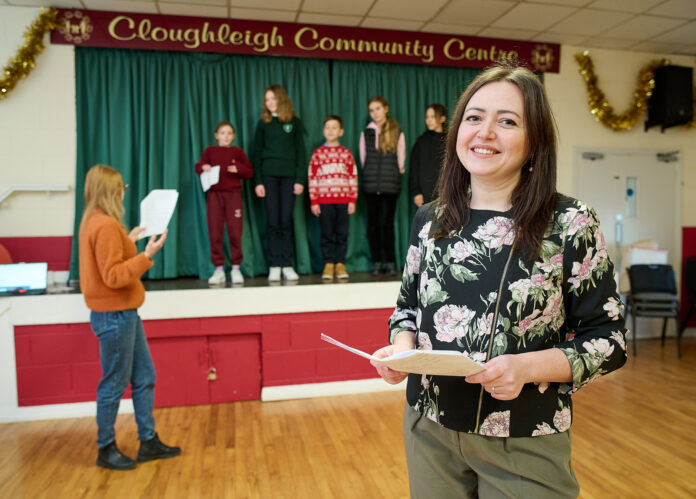SAINT Nicholas will pay a visit to Ennis this weekend as part of an interactive theatre production which aims to bring joy to Ukrainian children in Clare.
On Sunday, December 18 the Feast of St Nicholas, the Civic Room of the Buttermarket Building in Drumbiggle will be transformed by Ennis drama club “Ptashka” and Clare Local Development Company for their ‘St Nicholas Workshop’ performance.
The event will feature workshops, sweets, gifts and, of course, a meeting with your favourite saint Saint Nicholas.
The first performance of the Ptashka drama group is the Saint Nicholas holiday. St Nicholas, Sviatyij Mykolai, comes to Ukraine on December 19 in the Orthodox Julian calendar. The night before, December 18 is often called “Magic Night”. It is seen as a universal children’s festival, when the saint leaves sweets or games for children.
It is also a Ukrainian tradition for children to perform a play in honour of Saint Nicholas.
“We believe that it will be a real joy not only for the members of the club, but also for all our children in Ennis,” says Maryna Kravtsova, head of the group. “Saint Nicholas will find every child – even here in Ireland.”
“We have already got our St Nicholas costume, it came to us from Ukraine. Because it was very important for us that the “real” Nicholas visited the children, in Orthodox clothing. Exactly as he does in Ukraine. There will be a Christmas tree and sweets. The Saint will definitely find every child, even here in Ireland,” says Maryna.
Last November the drama club Ptashka (transl. as bird) accepted its first students in Ennis
“On Wednesday, November 9, our Ukrainian little birds visited the theatre studio for the first time. It was a joyful and rather touching meeting not only for children, but also for their parents.”
Monica McKenna, SICAP Coordinator Ukrainian Response Clare Local Development Company says, “Our drama club is more than a theatre studio where we will prepare performances. This is a place where children can find friends, communicate in their native language, enjoy the realisation of their talents, enjoy delicacies, and relax from a foreign language environment.
“We have an incredibly talented teacher, Ms Maryna, who worked as the head of a theatre studio in Balaklia for 16 years. We have a lot of ideas and plans.”
About 20 children attend the club at different times. Mostly, they live in hotels in Ennis town. However, there are a few children whose parents bring them from Bunratty.
“Despite the fact that it is not close, we cooperated with several parents and bring children one by one. We feel that it is very important for them to develop, communicate and just be happy. Yes, we also have the opportunity to talk a little in the kitchen while our kids are busy. We have tea or coffee and just talk. We often share our experiences, give each other some advice,” says the mother of one of the club’s members.
Traditional Christmas in Ukraine starts on January 6 (Christmas Eve in the Julian calendar). It lasts until the Feast of Epiphany on January 19. At the same time, more and more Ukrainians celebrate Christmas according to the Gregorian calendar on December 25. Mid-December is when the Christmas atmosphere begins to fill Ukrainian cities, with all Christmas markets and festivals, decorations and magic lights.
Christmas songs are an integral part of the whole holiday season, too. In Ukraine, there are two types of Christmas songs – koliadky (comes from the word ‘calendar’ which starts with the birth of Christ) for Christmas and shchedrivky (comes from the Ukrainian word for generosity).
‘Carol of the Bells’ is, in fact, originally a Ukrainian carol called Shchedryk (composed by Mykola Leontovych at the beginning of the XX century, based on the ancient Ukrainian folk songs).
Christmas Eve January 6 (Holy Eve) is marked by traditional family gatherings in the evening in Ukraine – the so-called Sviata Vecheria (‘Holy Dinner’). The festivities start with the appearance of the first star, though all preparations traditionally start from the very dawn.
The table should be served with 12 dishes, (all vegetarian) which symbolize the twelve apostles. The main meal is Kutia (boiled wheat mixed with poppy seeds and honey).
The main house decoration that you’ll see is the didukh (a sheaf of wheat stalks) that symbolizes our ancestors’ spirits. It is believed that during these holy days – our ancestors return to spend time with their families. That is also why some Kutia and other dishes should be left on the table – as a treat for deceased relatives.
So it all starts calmly and at home. However, big street celebrations soon follow. Boys and girls prepare special songs and verses they take from house to house, entertaining their community in exchange for sweet gifts and tips. It is believed, the more carolers come to the home, the more fortune and wealth will be brought to the family during the following year.
On January 7, or their Christmas Day using theJulian Calendar traditionally, children also prepare and perform so-called vertep performances. Vertep is a portable puppet theatre and drama which presents the nativity scene and other mystery plays. The essential attribute of the vertep is the Christmas star, which is considered a symbol of joy (as it bears the news of the birth of Jesus).
While January 13 marks Malanka, a traditional Ukrainian celebration of the ‘Old New Year’ with new years’s day on January 14.


